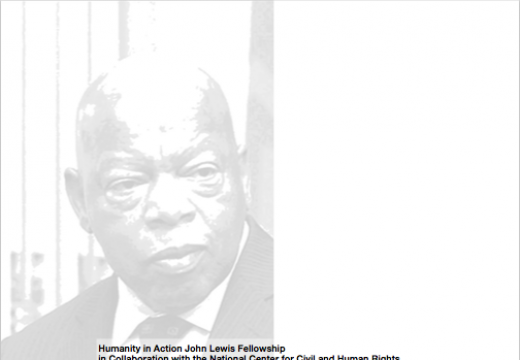Details
Article

Walking along the south side of the historic Edgewood Ave, there are three murals that coat and transform the walls of a once inconspicuous building. Painted by three different artists, each wall has a distinct style but an unmistakable common theme: education. These murals were commissioned by the “Education is not a Crime” campaign which uses public art to draw attention to educational discrimination and human rights abuses in major cities all around the world. I have held the images of these three murals in the forefront of my mind throughout the John Lewis Fellowship Program because, 1.) As someone who teaches and is involved in educational issues myself, I consider Atlanta’s opportunities and challenges through the lens of education, 2.) I find that many of the themes we’ve discussed connect to, challenge, and reinforce the messages of these three murals, and 3.) Student led activism is central to civil rights in Atlanta.
The mural on the west facing wall is called “Watch Me Learn” by Charmaine Minniefield and features an iconic 1969 photograph of community members “taking education in their own hands” in the oppressive Jim Crow South. Dr. Carol Anderson told us that during Jim Crow, funding for white schools was 250% more than black schools and about 63% of black adults had less than 5 years of Jim Crow education. In addition to such blatant denial of educational rights, the literacy tests
The mural shows 400 years of African American history reduced to only one page of a U.S. history book, pointing to the gross failure of the U.S. to critically engage with and acknowledge its past.

administered to black voters were so absurd that they were practically impossible to pass. Restricting and manipulating education to disempower communities has been carefully crafted throughout history and we must be vigilant to such practices today. This mural celebrates education as a powerful and brave act of resistance against the institutions that attempt, both covertly and overtly, to use knowledge as a means of control and marginalization. Emiko Soltis, the director of Freedom University, describes education as resistance when she said “education, and more specifically popular education, is a force of liberation, empowerment, and mobilization.”
The second mural is called “The Paragraphalizer” by Fabian Williams. The mural shows 400 years of African American history reduced to only one page of a U.S. history book, pointing to the gross failure of the U.S. to critically engage with and acknowledge its past. This Fellowship has shown me the importance of identifying patterns of oppression throughout history so that we can recognize the continuation and active recreation of such patterns in the present and hold institutions accountable, no matter how deceptive they might be. However, this mural could also have been expanded to highlight the silencing of Native American history. Professor Churchill emphasized that the narrative of Native American history taught in schools has been so “sanitized and intentionally saturated with denial” that we have reached a dangerous state of “collective amnesia.”
In his workshop, Dr. David Hooker drew a powerful connection between history and resistance that illustrates the power of education in justice work. Dr. Hooker said, “Knowledge is the manifestation of power” because those holding power dictate what knowledge has value and which narratives have “testimonial authority” over others. The information that forms the basis of what we know about his- tory is recorded, crafted, and disseminated by those with power. Therefore, critically engaging with history has the potential to destabilize dominant cultural and institutional narratives. To do this in the classroom, I will use “critical pedagogy”, which prioritizes critical and creative thinking as a form of resistance. It is through “critical pedagogy,” as Freire explained in Pedagogy of the Oppressed, that students “discover how to participate [as active agents] in the transformation of their world.”
The third mural by Joe Dreher is called “Educate, Elevate, Empower.” We see three women: the first is a child who looks up to the world with awe and curiosity; the second is a teen with wings outstretched who is more aware of herself and her surroundings; and the third is an adult who can guide and empower the younger generations. The sharing of multigenerational knowledge builds community and a sense of civic responsibility. This mural illustrates Dr. Roslyn Pope’s belief in the need to pair the “unencumbered vision of youth” with the “wisdom and experience of elders.”
My experiences in the John Lewis Fellowship and in Atlanta have reinforced my commitment to education as a powerful method of resistance and social change.
Dr. Roslyn Pope and Charles Black provide an example of this statement in practice. Drawing from their experience as leaders in the Atlanta Student Movement, they offer guidance and stand in solidarity with current student leaders, specifically students of Freedom University. Freedom University is a freedom school in Atlanta that “fights to remove barriers to higher education for undocumented students” by empowering and mobilizing those “directly impacted by injustice.” As the Atlanta Student Movement also did, Freedom University prides itself in being highly organized, disciplined, and strategic. The Freedom University strategy is also multidimensional in that it uses direct actions, policy campaigns, and partnerships with diverse allies.
Inspired by Freedom University’s model of resistance and Atlanta’s student leaders, as well as other community leaders we have met throughout the Fellowship, I plan to continue to address to civil and human rights through the framework of education. My experiences in the John Lewis Fellowship and in Atlanta have reinforced my commitment to education as a powerful method of resistance and social change.



